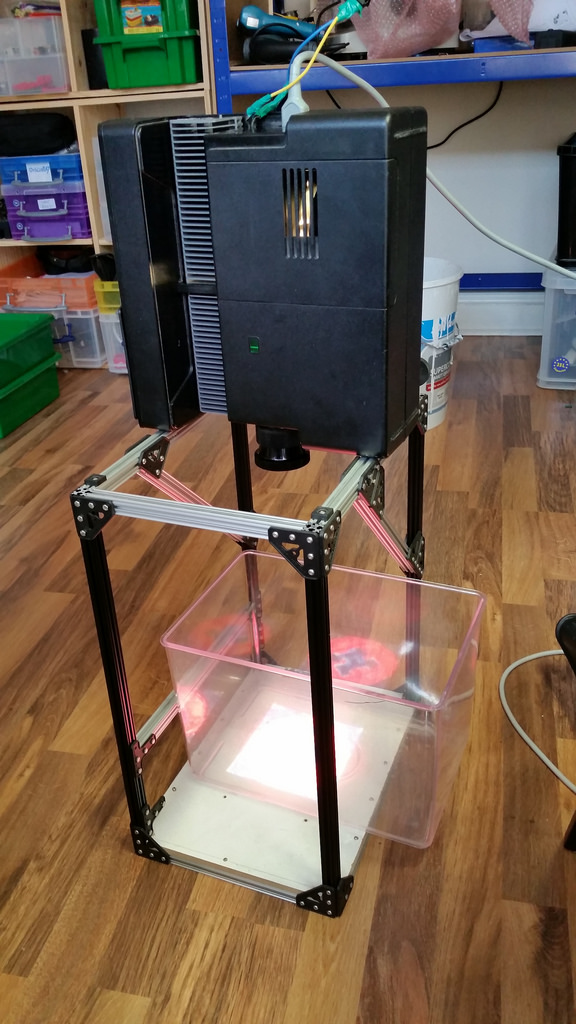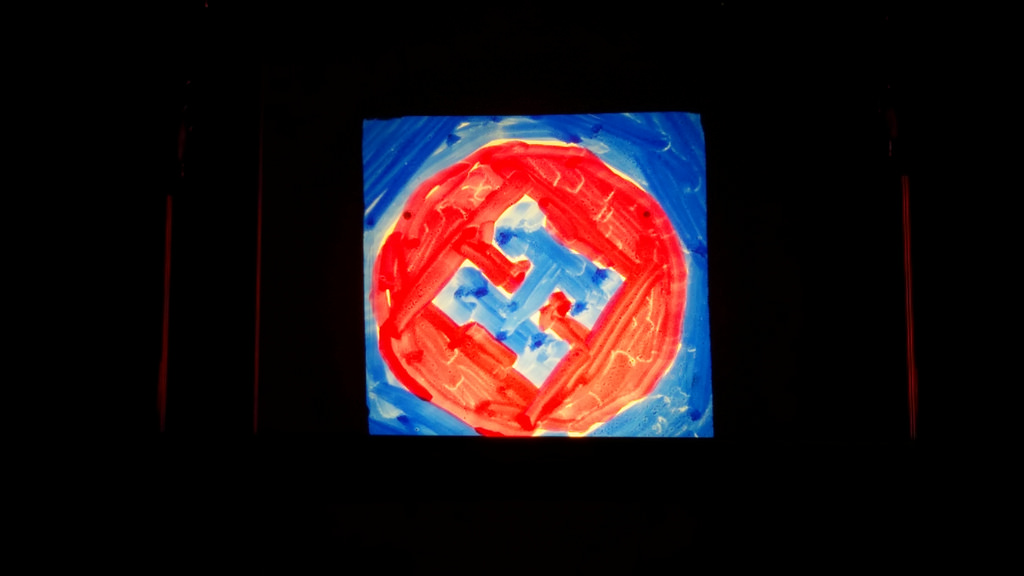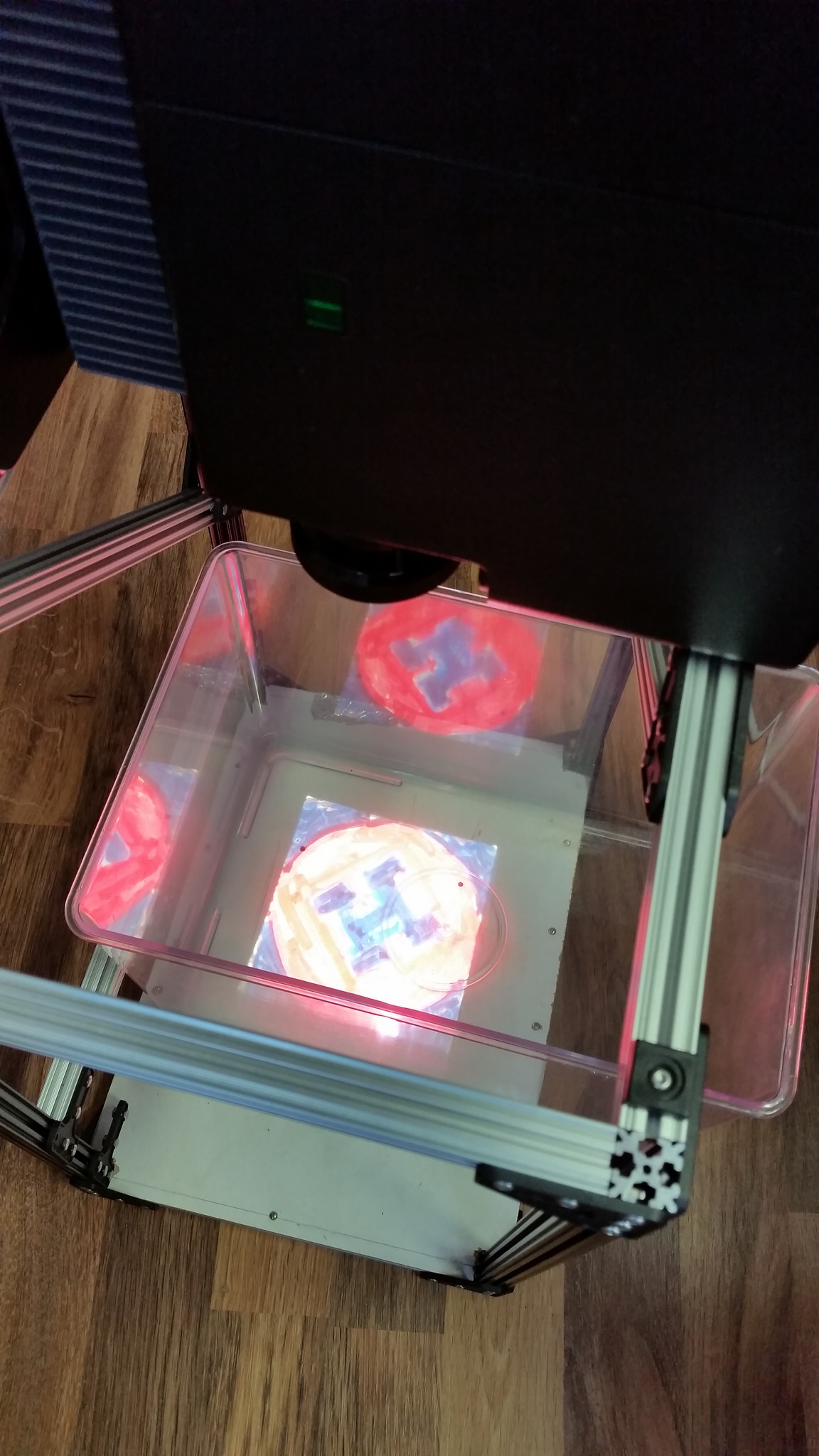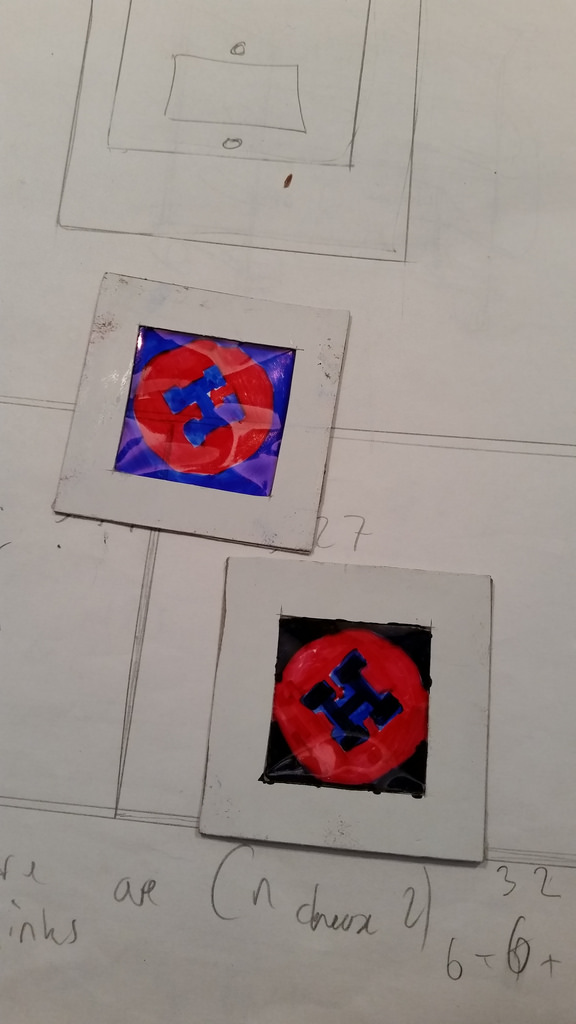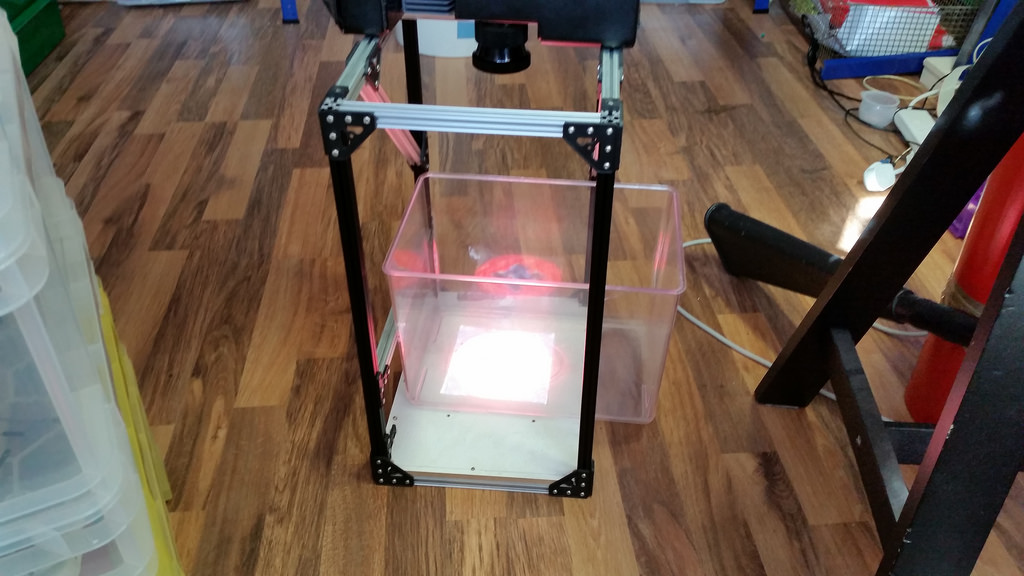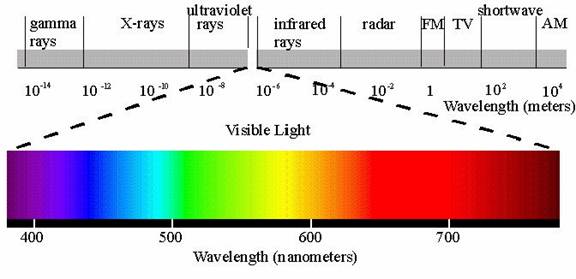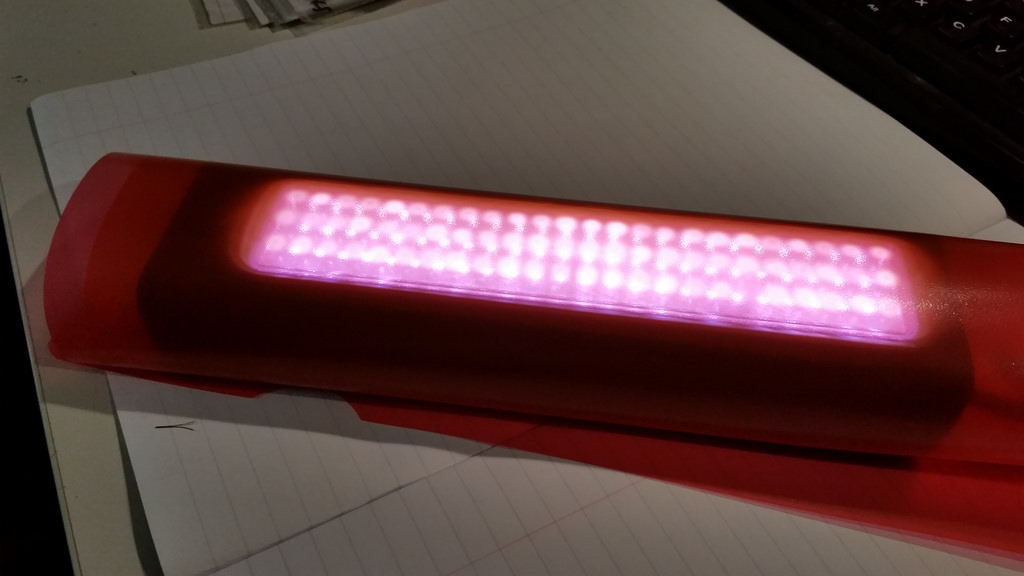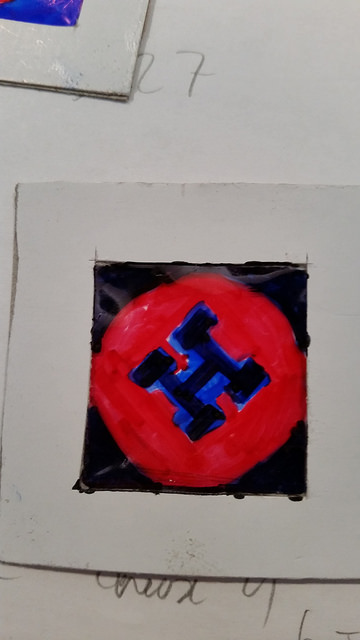Team:London BioHackspace/Printer Hardware
From 2014.igem.org
(Created page with "{{CSS/Main}} {{Team:London_BioHackspace/navbar}}") |
m (→Methods) |
||
| (17 intermediate revisions not shown) | |||
| Line 1: | Line 1: | ||
{{CSS/Main}} | {{CSS/Main}} | ||
{{Team:London_BioHackspace/navbar}} | {{Team:London_BioHackspace/navbar}} | ||
| + | |||
| + | ==Intro== | ||
| + | |||
| + | [[File:15259724148 b72dec6fe7 b.jpg|thumb|300px]] | ||
| + | The basic proposal for juicyprint is the growth of cellulose by bacteria under the control of light. The 660nm light that the Cph1 protein is sensitive to inhibits the growth. Therefore we designed a system to generate the production of a pellicle sheet in the shape of a projected template of the negative image. | ||
| + | |||
| + | Our initial prototype only addresses the situation of producing 2d templates. | ||
| + | |||
| + | {| | ||
| + | |So a light pattern like this | ||
| + | |should result in a pellicle growth pattern like this | ||
| + | |- | ||
| + | |[[File:Hackspace logo.png|200px]] | ||
| + | |[[File:Hackspace logo2dwqdwqdwq.png|200px]] | ||
| + | |} | ||
| + | |||
| + | ==Aim== | ||
| + | |||
| + | The primary aim is to demonstrate a mechanical system which can be used to provide a light source and as a basic proof of concept. | ||
| + | |||
| + | In future it would be ideal to use an platform that can be raised in the Z direction to enable the production of 3d images. | ||
| + | |||
| + | |||
| + | This is a gallery of a series of images from basic prototypes and some initial tests | ||
| + | <gallery> | ||
| + | File:15422909736 4b06586aa6 b.jpg | ||
| + | File:15443143861 b2bb93fb73 k.jpg | ||
| + | File:15443184581 34c2d728c5 b.jpg | ||
| + | File:15445980122 77a35d7276 b.jpg | ||
| + | </gallery> | ||
| + | |||
| + | ==Methods== | ||
| + | |||
| + | We were unable to fully test the system with the target bacterial system. Therefore we simulated the process with just a liquid target. | ||
| + | |||
| + | 660nm light is a bright red colour; | ||
| + | |||
| + | [[File:Image002igh875yt785y87t5y4.jpg]] | ||
| + | |||
| + | <code>Image courtesy of Beer Color Laboratories; | ||
| + | http://www.beercolor.com/color_basics1.htm</code> | ||
| + | |||
| + | |||
| + | We tested a number of light sources to be able to generate 660nm patterns easily. | ||
| + | <gallery> | ||
| + | File:14939024114 e7aa0d51ca b.jpg | ||
| + | File:15536077496 9326a7fb0d b.jpg | ||
| + | File:15557111841_44a7168e0f_b.jpg | ||
| + | </gallery> | ||
| + | |||
| + | [[File:15446012882 3495bcc65b z.jpg|frame]] | ||
| + | |||
| + | ==Results== | ||
| + | |||
| + | A thick 660nm camera filter gets very hot when placed near the projector for a period of time. | ||
| + | |||
| + | Therefore I settled on using a home-made red permanent marker pen to make a 35mm slide suitable for projection. The slide was much thinner and didn't absorb so much light and get hot. | ||
| + | |||
| + | |||
| + | In the end, a diy 35mm slide was the best way to project red light easily. | ||
| + | |||
| + | |||
| + | |||
| + | |||
| + | ==Conclusions & future work== | ||
| + | |||
| + | Would probably spend more time making a slide that was closer to a perfect 660nm filter. | ||
| + | |||
| + | I didn't leave the slide under the projector for very long as I feared it would melt. I think a professionally manufactured slide might be more resilient. | ||
| + | |||
| + | |||
| + | |||
| + | |||
| + | |||
| + | |||
| + | |||
| + | |||
| + | |||
| + | |||
| + | |||
| + | |||
| + | |||
| + | |||
| + | |||
| + | |||
| + | |||
| + | |||
| + | <code>London Biohackers</code> | ||
Latest revision as of 01:11, 18 October 2014
| Home | Project | Team | Policy & Practice | Protocols | Safety |  |
Contents |
Intro
The basic proposal for juicyprint is the growth of cellulose by bacteria under the control of light. The 660nm light that the Cph1 protein is sensitive to inhibits the growth. Therefore we designed a system to generate the production of a pellicle sheet in the shape of a projected template of the negative image.
Our initial prototype only addresses the situation of producing 2d templates.
| So a light pattern like this | should result in a pellicle growth pattern like this |
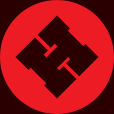
| 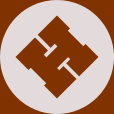
|
Aim
The primary aim is to demonstrate a mechanical system which can be used to provide a light source and as a basic proof of concept.
In future it would be ideal to use an platform that can be raised in the Z direction to enable the production of 3d images.
This is a gallery of a series of images from basic prototypes and some initial tests
Methods
We were unable to fully test the system with the target bacterial system. Therefore we simulated the process with just a liquid target.
660nm light is a bright red colour;
Image courtesy of Beer Color Laboratories;
http://www.beercolor.com/color_basics1.htm
We tested a number of light sources to be able to generate 660nm patterns easily.
Results
A thick 660nm camera filter gets very hot when placed near the projector for a period of time.
Therefore I settled on using a home-made red permanent marker pen to make a 35mm slide suitable for projection. The slide was much thinner and didn't absorb so much light and get hot.
In the end, a diy 35mm slide was the best way to project red light easily.
Conclusions & future work
Would probably spend more time making a slide that was closer to a perfect 660nm filter.
I didn't leave the slide under the projector for very long as I feared it would melt. I think a professionally manufactured slide might be more resilient.
London Biohackers
 "
"
